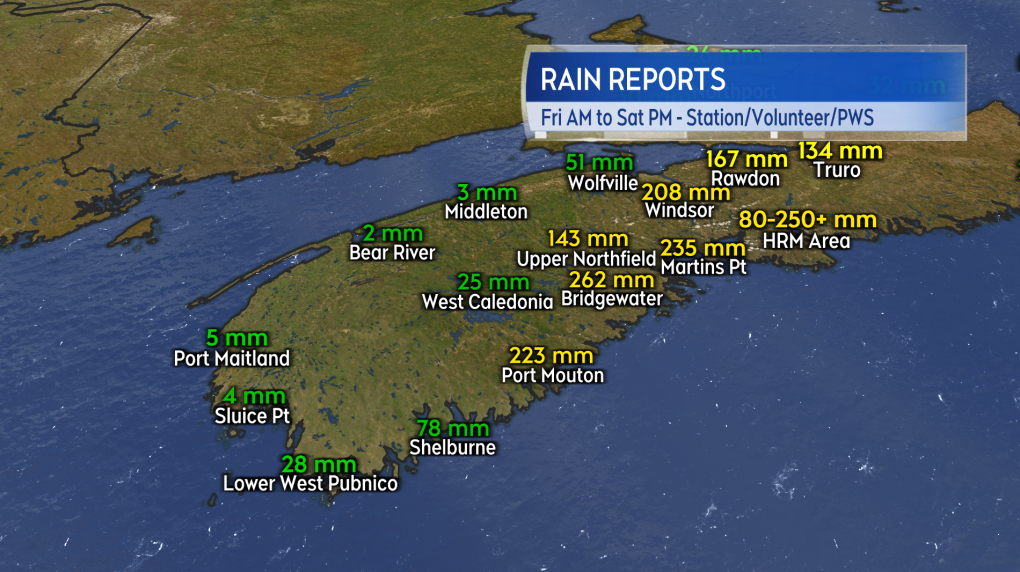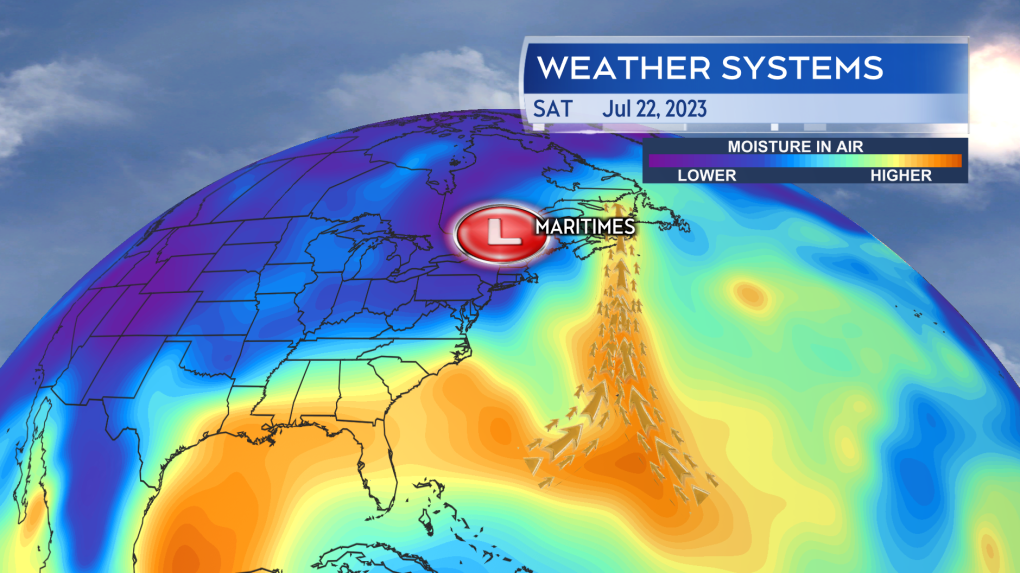Rain in Nova Scotia ranks among historical events
With a large swath of rain totaling more than 200 millimetres -- much of it falling in less than 12 hours -- this weather event will rank among the worst historical floods for Nova Scotia.
 Preliminary rainfall reports in the western half of the province.
Preliminary rainfall reports in the western half of the province.
The very heaviest of the rain started on the South Shore of Nova Scotia and then continued up into Halifax Regional Municipality and Hants County. Dozens of personal weather stations operating in the province totalled rain in excess of 200 millimetres. A radar estimate by Environment Canada indicates that some rain totals in the vicinity of Panuke Lake may have exceeded 300 millimetres.
 Some of the suburban areas of the Halifax Regional Municipality were hit particularly hard by dozens of rounds of downpours and thunderstorms.
Some of the suburban areas of the Halifax Regional Municipality were hit particularly hard by dozens of rounds of downpours and thunderstorms.
It wasn’t just the total amounts of rain that created catastrophic flooding but the rate at which it arrived as well. Rain totals were estimated to be upwards of 30 millimetres per hour and that was confirmed by Environment Canada-operated weather stations at Debert and Bedford Range, which both pick up one hour rain amounts nearing 40 millimetres.
 A slow-moving low-pressure system acted to reinforce tropical air moving up from the south, providing a feed of moisture into the downpours and thunderstorms.
A slow-moving low-pressure system acted to reinforce tropical air moving up from the south, providing a feed of moisture into the downpours and thunderstorms.
The totals are comparable to events such as the November 2021 floods in Cape Breton, the Thanksgiving Day flood of October 2016 in Cape Breton, and Hurricane Beth in 1971. Compared to those events though, these totals appear to have arrived in an even shorter duration. For example, the 266 millimetres of rain reported by Halifax International Airport due to Hurricane Beth is over 30 hours as opposed to 12 hours or less.
Daily and possibly monthly rain records are likely to have been set for some areas. CTV News contacted Environment Canada for more on historical records. They are in the process of gathering data on the event and will release further information on records when done.
 Moving into Saturday evening, the most remaining downpours are centred on the Eastern Shore of Nova Scotia and Cape Breton. Rain totals continue to add up and the downpours are forecast to ease to showers Saturday night into Sunday morning.
Moving into Saturday evening, the most remaining downpours are centred on the Eastern Shore of Nova Scotia and Cape Breton. Rain totals continue to add up and the downpours are forecast to ease to showers Saturday night into Sunday morning.
Periodic rain and downpours continues for parts of eastern Nova Scotia moving into Saturday evening. It looks unlikely that the eastern parts of the province will match the extremes seen in locations further to the west. That said, a number of weather stations are reporting totals in a range of 50 to just over 100 millimetres. Flooding and flash flooding remains a risk. The last area of the province to get out of the periods of heavier rain will be Cape Breton.
Cape Breton is expected to see the downpours east to showers Saturday night into early Sunday morning.
For more Nova Scotia news visit our dedicated provincial page.
CTVNews.ca Top Stories

Poilievre writes to GG calling for House recall, confidence vote after Singh declares he's ready to bring Liberals down
Conservative Leader Pierre Poilievre has written to Gov. Gen. Mary Simon, imploring her to 'use your authority to inform the prime minister that he must' recall the House of Commons so a non-confidence vote can be held. This move comes in light of NDP Leader Jagmeet Singh publishing a letter stating his caucus 'will vote to bring this government down' sometime in 2025.
BREAKING At least 2 dead and 60 hurt after a car drives into a German Christmas market in a suspected attack
A car plowed into a busy outdoor Christmas market in the eastern German city of Magdeburg on Friday, killing at least two people and injuring at least 60 others in what authorities suspect was an attack.
Judge sentences Quebecer convicted of triple murder who shows 'no remorse'
A Quebecer convicted in a triple murder on Montreal's South Shore has been sentenced to life in prison without chance of parole for 20 years in the second-degree death of Synthia Bussieres.
'I understand there's going to be a short runway,' new minister says after Trudeau shuffles cabinet
Prime Minister Justin Trudeau added eight Liberal MPs to his front bench and reassigned four ministers in a cabinet shuffle in Ottawa on Friday, but as soon as they were sworn-in, they faced questions about the political future of their government, and their leader.
BREAKING Fake nurse Brigitte Cleroux sentenced to 7 years in prison
A woman who illegally treated nearly 1,000 patients in British Columbia while impersonating a nurse has been sentenced to seven years in prison.
Poilievre to Trump: 'Canada will never be the 51st state'
Conservative leader Pierre Poilievre is responding to U.S. president-elect Donald Trump’s ongoing suggestions that Canada become the 51st state, saying it will 'never happen.'
Toronto officials warn of possible measles exposure at Pearson airport
Toronto Public Health (TPH) is advising of another possible measles exposure at Canada’s largest airport.
Bail denied for Winnipeg woman accused of killing animals in online videos
Warning: This story contains disturbing details. Discretion is advised. A Winnipeg woman accused of making videos of animals being tortured and killed that were sold on the dark web was denied bail.
Party City closing in U.S., Canadian stores remain 'open for business'
The impending closure of all Party City locations in the United States will not extend into Canada.
































